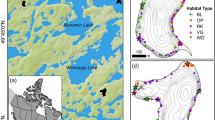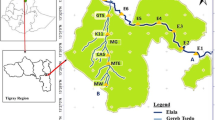Abstract
Two native New Zealand galaxiid fishes [the kōaro (Galaxias brevipinnis) and the shortjaw kōkopu (Galaxias postvectis)] are declining throughout the country. More knowledge regarding aspects of their ecology is needed in order for conservation actions to be optimally designed. A 100-m reach of small upland stream in Manawatu, New Zealand was mapped to scale and inventoried for microhabitat variables. Flow velocity, depth, surface turbulence, substrate size and interstitial refuge space availability were measured in 0.25-m2 quadrats throughout the reach. Twenty-nine kōaro and 22 shortjaw kōkopu were PIT-tagged within the reach and monitored during the day (N = 26) and night (N = 15) in 2008 with a portable PIT monitoring system. Of these, 72 % of kōaro and 68 % of shortjaw kōkopu were detected at least once and 62 % of kōaro and 46 % of shortjaw kōkopu were detected five times or more within the study reach. During both the day and night kōaro used microhabitats that were faster-flowing, deeper, more turbulent, with larger substrate particles and more interstitial refuge spaces when compared with all microhabitats available in the reach. Shortjaw kōkopu used microhabitats with larger substrate particles and more interstitial refuge spaces when compared to all microhabitats available within the reach. During the day, shortjaw kōkopu were found in areas with larger substrates and higher surface turbulence than areas where they were found at night. Four mesohabitat types were identified in the study area using cluster analyses. Kōaro used the same flow channel-type habitats during the day and at night. Shortjaw kōkopu used flow channel and pool habitats during the day, and used pool habitats at night. These results suggest that biotic factors such as competition from shortjaw kōkopu may have been influencing kōaro habitat use patterns. In addition, these findings have implications for river managers attempting to implement conservation measures to protect these species because increasing anthropogenic impacts such as sedimentation and water abstraction can have negative impacts on instream habitat.


Similar content being viewed by others
References
Allibone RM (2000) Water abstraction impacts on non-migratory galaxiids of Otago streams. Science for Conservation 147. Department of Conservation, Wellington, New Zealand
Allibone R, David B, Hitchmough R, Jellyman D, Ling N, Ravenscroft P, Waters J (2010) Conservation status of New Zealand freshwater fish, 2009. N Z J Mar Fresh 44:271–287
Baker CF, Smith JP (2007) Habitat use by banded kōkopu (Galaxias fasciatus) and giant kōkopu (G. argenteus) co-occurring in streams draining the Hakarimata Range. N Z J Mar Fresh 41:25–33
Benejam L, Angermeier PL, Munné A, García-Berthou E (2010) Assessing effects of water abstraction on fish assemblages in Mediterranean streams. Freshw Biol 55:628–642
Breen MJ, Ruetz CR, Thompson KJ, Kohler SL (2009) Movements of mottled sculpins (Cottus bairdii) in a Michigan stream: how restricted are they? Can J Fish Aquat Sci 66:31–41
Chadderton WL, Allibone RM (2000) Habitat use and longitudinal distribution patterns of native fish from a near pristine Stewart Island, New Zealand. N Z J Mar Fresh 34:487–499
Crow SK (2007) Evolutionary Ecology of Non-Diadromous Galaxiid Fishes (Galaxias gollumoides and G. ‘southern’) in Southern New Zealand. PhD Thesis, University of Otago, New Zealand
Cucherousset J, Paillisson JM, Roussel JM (2007) Using PIT technology to study the fate of hatchery-reared YOY northern pike released into shallow vegetated areas. Fish Res 85:159–164
Cucherousset J, Roussel JM, Keeler R, Cunjak RA, Stump R (2005) Use of two new portable 12-mm PIT tag detectors to track small fish in shallow streams. N Am J Fish Manage 25:270–274
Davey AJH, Booker DJ, Kelly DJ (2011) Diel variation in stream fish habitat suitability criteria: implications for instream flow assessment. Aquat Conserv 21:132–145
Dirnwoeber M, Machan R, Herler J (2012) Coral reef surveillance: Infrared-sensitive video surveillance technology as a new tool for diurnal and nocturnal long-term field observations. Remote Sens 4:334–63362
Edge KA, Townsend CR, Crowl TA (1993) Investigating anti-predator behaviour in three genetically differentiated populations of non-migratory galaxiid fishes in a New Zealand river. N Z J Mar Fresh 27:357–364
Fortin MJ, Dale MRT (2005) Spatial analysis: a guide for ecologists. Cambridge University Press, Cambridge
Hayes JW, Leathwick JR, Hanchett SM (1989) Fish distribution patterns and their association with environmental factors in the Mokau catchment, New Zealand. N Z J Mar Fresh 23:171–180
Hayes ML (1996) Active fish capture methods. In: Murphy BR, Willis DW (eds) Fisheries Techniques. American Fisheries Society, Herndon, Virginia, c/o Books International
Henry BE, Grossman GD (2008) Microhabitat use by blackbanded (Percina nigrofasciata), turquoise (Etheostoma inscriptum), and tessellated (E. olmstedi) darters during drought in a Georgia piedmont stream. Environ Biol Fish 83:171–182
Hill MS, Zydlewski GB, Zydlewski JD, Gasvoda JM (2006) Development and evaluation of portable PIT tag detection units: PITpacks. Fish Res 77:102–109
Hosmer DW, Lemeshow S (2000) Applied logistic regression, 2nd edn. A Wiley Interscience Publication, New York
Jakober MJ, McMahon TE, Thurow RF (2000) Diel habitat partitioning by bull char and cutthroat trout during fall and winter in Rocky Mountain streams. Environ Biol Fish 59:79–89
Johnson SL, Covich AP (2000) The importance of night-time observations for determining habitat preferences of stream biota. Regul River 16:91–99
Jowett IG, Boustead NC (2001) Effects of substrate and sedimentation on the abundance of upland bullies (Gobiomorphus breviceps). N Z J Mar Fresh 35:605–613
Jowett IG, Richardson J (1995) Habitat preferences of common, riverine New Zealand native fishes and implications for flow management. N Z J Mar Fresh 29:13–23
Joy MK, Death RG (2004) Predictive modelling and spatial mapping of freshwater fish and decapod assemblages using GIS and neural networks. Freshw Biol 49:1036–1052
Leathwick JR, Rowe D, Richardson J, Elith J, Hastie T (2005) Using multivariate adaptive regression splines to predict the distributions of New Zealand’s freshwater diadromous fish. Freshw Biol 50:2034–2052
Legendre P (1993) Spatial autocorrelation: trouble or new paradigm? Ecology 74:1659–1673
Linnansaari TP, Cunjak RA (2007) The performance and efficacy of a two-person operated portable PIT-antenna for monitoring spatial distribution of stream fish populations. River Res Appl 23:559–564
McDonald JH (2008) Handbook of biological statistics. Sparky House Publishing, Baltimore
McDowall RM (1990) New Zealand freshwater fishes: a natural history and guide. Heinemann Reed, Auckland
McDowall RM, Eldon GA, Bonnett ML, Sykes JRE (1996) Critical habitats for the conservation of shortjawed kōkopu, Galaxias postvectis Clarke. Conservation Sciences Publication 5. Department of Conservation, Wellington. 80p
McEwan AJ (2009) Fine scale spatial behavior of indigenous riverine fish in a small New Zealand stream. MSc Thesis, University of Massey, New Zealand
McEwan AJ, Joy MK (2011) Monitoring a New Zealand freshwater fish community using passive integrated transponder technology; lessons learned and recommendations for future use. N Z J Mar Fresh 45:137–149
McEwan AJ, Joy MK (2013) Habitat use of redfin bullies (Gobiomorphus huttoni) in a small upland stream in Manawatu, New Zealand. Environ Biol Fish. doi:10.1007/s10641-013-0131-9
McIntosh AR, Townsend CR, Crowl TA (1992) Competition for space between introduced brown trout (Salmo trutta L.) and a native galaxiid (Galaxias vulgaris Stokell) in a New Zealand stream. J Fish Biol 41:63–81
Main MR (1988) Factors influencing the distribution of kokopu and koaro (Pisces; Galaxiidae). MSc Thesis, University of Canterbury, New Zealand
Main MR, Eldon GA, Nichol GJ (1985) Distribution and biology of freshwater fishes in the Cook River to Paring River area, South Westland. Fisheries environmental report no. 60. Fisheries research division, Ministry of Agriculture and Fisheries ISSN 0111-4794 142p
Martinez-Capel F, De Jalon DG, Werenitzky D, Baeza D, Rodilla-Alama M (2009) Microhabitat use by three endemic Iberian cyprinids in Mediterranean rivers (Tagus River Basin, Spain). Fish Manag Ecol 16:52–60
Nielsen LA, Johnson DL (eds) (1983) Fisheries Techniques. American Fisheries Society, Bethesda
O’Donnell MJ, Horton GE, Letcher BH (2010) Use of portable antennas to estimate abundance of PIT-tagged fish in small streams: factors affecting detection probability. N Am J Fish Manag 30:323–336
Olden JD, Jackson DA (2001) Fish-habitat relationships in lakes: gaining predictive and explanatory insight by using artificial neural networks. T Am Fish Soc 130:878–897
Orth DJ (1987) Ecological considerations in the development and application of instream flow-habitat models. Regul River 1:171–181
R Development Core Team (2011) R: A Language and Environment for Statistical Computing. R Foundation for Statistical Computing, Vienna, Austria. http://www.R-project.org. Accessed 21 April 2011
Richardson J, Jowett IG (2002) Effects of sediment on fish communities in East Cape streams, North Island, New Zealand. N Z J Mar Fresh 36:431–442
Roussel JM, Haro A, Cunjak RA (2000) Field test of a new method for tracking small fishes in shallow rivers using passive integrated transponder (PIT) technology. Can J Fish Aquat Sci 57:1326–1329
Rowe DK (1981) Fisheries investigations in the Motu River. Fisheries Environmental Report No. 11. Rotorua, Fisheries Research Division, Ministry of Agriculture and Fisheries
Rowe DK, Chisnall BL, Dean TL, Richardson J (1999) Effects of land use on native fish communities in east coast streams of the North Island of New Zealand. N Z J Mar Fresh 33:141–151
Ryan PA (1991) Environmental effects of sediment on New Zealand streams: a review. N Z J Mar Fresh 25:207–221
Thompson AR, Baskin JN, Swift CC, Haglund TR, Nagel RJ (2010) Influence of habitat dynamics on the distribution and abundance of the federally threatened Santa Ana Sucker Catostomus santaanae, in the Santa Ana River. Environ Biol Fish 87:321–332
Wentworth CK (1922) A scale of grade and class terms for clastic sediments. J Geol 30:377–392
West DW (1989) The ecology of native and introduced fish in some Waikato streams. MSc Thesis, University of Waikato, New Zealand
Wild M, Snelder T, Leathwick JR, Shankar U, Hurren H (2004) Environmental variables for the Freshwater Environments of New Zealand River Classification. Client Report CHC2004-086. Christchurch, NIWA
Winterbourn MJ, Rounick JS, Cowie B (1981) Are New Zealand stream ecosystems really different? N Z J Mar Fresh 15:321–328
Acknowledgments
We gratefully acknowledge Alton Perrie for assistance with all stages of field work and Patrick and Marlene Anderson for allowing access to the Mangaore Stream. The Department of Conservation, the Whanganui River Enhancement Trust, the family of the late Julie Alley, and the Greater Wellington Regional Council provided assistance with funding and equipment. We thank Bruno David for his advice and for discussions on all phases of this work. This research was sanctioned by the Massey University Animal Ethics Committee (Protocol No. 07/30 and 07/106).
Author information
Authors and Affiliations
Corresponding author
Rights and permissions
About this article
Cite this article
McEwan, A.J., Joy, M.K. Diel habitat use of two sympatric galaxiid fishes (Galaxias brevipinnis and G. postvectis) at two spatial scales in a small upland stream in Manawatu, New Zealand. Environ Biol Fish 97, 897–907 (2014). https://doi.org/10.1007/s10641-013-0191-x
Received:
Accepted:
Published:
Issue Date:
DOI: https://doi.org/10.1007/s10641-013-0191-x




